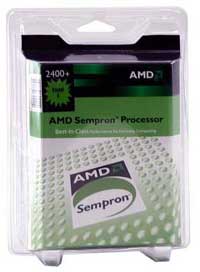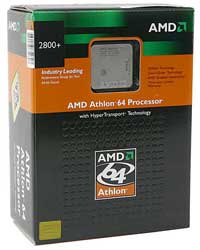Buyer's Guide - Entry Level, January 2005
by Jarred Walton on January 9, 2005 12:05 AM EST- Posted in
- Guides
CPU and Motherboard: AMD
We have two options with AMD: socket A or socket 754. Socket 754 costs more, of course, but it generally has better performance and it will have some future processor updates. If you can spare the cash, we recommend going with socket 754. Those who want to save as much money as possible while still getting a decent system will be better served by socket A. This is particularly true if you want to look at motherboards with integrated graphics, as there really aren't many socket 754 boards that include graphics and the quality of the included graphics is almost universally poor. For the cost conscious, then, we'll go with socket A and integrated graphics, and we'll stick with socket 754 as a performance alternative. Socket 939 is yet another alternative, but we feel that the price is just too high now to reasonably fit into a budget system.  |
 |
| Click images to enlarge. | |
Socket A Motherboard: MSI K7N2GM2-LSR Nforce2 IGP
Price: $72 shipped
Socket A CPU: AMD Sempron 2400+ 256K 1.67 GHz 333 MHz bus
Price: $63 shipped (Retail)
Total: $135
In terms of cost, the Nforce2 IGP motherboards have quite a bit to offer. You get graphics that are roughly the equivalent of a $30 add-in card along with reasonable performance. Reliability of the MSI boards has been very good in our experience, and we also get a few extras. For example, we get SATA hard drive support, courtesy of the more recent MCP-S NVIDIA chip, and all Nforce2 IGP chips have dual-channel RAM support. Unfortunately, we also lose some features like the third DIMM socket and several PCI slots - this is a micro-ATX board instead of a full-size ATX. None of these losses are really that bad, however, and the board as a whole strikes a good balance between cost, features, and performance. MSI also includes their pseudo-rounded IDE and floppy cables, and although they're not as nice as a true rounded cable, they're better than flat IDE/floppy cables in our opinion.
There are several similar boards that make different trade-offs in this price range. For example, we can get a third DIMM socket but lose the SATA support with something like the Chaintech 7NIF2. If we look towards non-IGP solutions, there are even more possibilities, including full-size ATX boards, boards that use a different chipset, firewire support, etc. We don't particularly care for most of the cheaper boards, however, and the more expensive boards get us into the territory of socket 754, making them a rather poor choice where performance is concerned. If you choose a non-IGP Nforce2 motherboard, you should also pay attention to the specific model of the chipset used, as the SPP version does not have dual-channel RAM support.
The processor selection is about the same as it has been for several months on socket A, and we continue to stick with the Sempron 2400+ as the most reasonable choice. Running at 1.67 GHz, it does well in most tasks. We would prefer to get one of the old Barton Athlon XP chips instead, but prices on those have increased and have taken them out of the reach of the budget system. The Athlon XP-M 2500+ can still be had for about $90, and when combined with a moderate heatsink and some overclocking, it can reach decent performance levels, but again, that is moving into the mid-range sector and the domain of the Athlon 64. For overall value, we still like the platform, but performance is nothing special. If you want more performance from an AMD system, we feel that you're better off spending the extra money to shift to socket 754 and the Athlon 64.
 |
 |
| Click images to enlarge. | |
Socket 754 Motherboard: Chaintech VNF-250 Nforce3 250
Price: $73 shipped
Socket 754 CPU: AMD Athlon 64 2800+ 1.8 GHz
Price: $127 shipped (Retail)
Total: $200
Shifting to socket 754, we choose to go with a motherboard that doesn't include integrated graphics. There are boards that use the VIA K8M800 chipset with its S3 UniChrome Pro graphics, and there are also boards that include the SiS Mirage graphics. Performance and reliability of either one are questionable in our opinion. If you don't need decent 3D acceleration, we'd just as soon go out and purchase a cheap Radeon or GeForce card for $30 to $45 and be assured of driver reliability. For the motherboard, then, we end up going with a discrete graphics solution and the tried-and-true Nforce3 250 chipset. There are a few options in the budget sector competing for the lowest price, with the cheapest board coming in at $70 shipped.
At the bottom of the price scale, we're going to stick with the Chaintech VNF-250, due to better memory compatibility. There are some specific memory compatibility issues with the EPoX boards, but they do win out in terms of price and features, depending on the model that you select - the EP-8KDA3I is the base model and costs $70 while the EP-8KDA3J adds Gigabit Ethernet and the hardware firewall of the 250Gb chipset and costs only a few dollars more. The drawback of the EPoX boards is that while they work well with one DIMM, they do not officially support running two double-sided DIMMs in anything more than DDR333 speeds. If you can live with that limitation, the 8KDA3J is still a good board, but we feel that many people will end up running two DIMMs with such a system - perhaps not initially, but adding a second 512 MB DIMM down the road seems very reasonable. Those looking for additional features might want to look at the Biostar K8NHA Grand, as it includes GbE via the 250Gb chipset and adds IEEE1394a firewire support to the mix. We really hate to skimp on the motherboard in any system, as it can have a far-reaching impact on performance and reliability. If it were us buying a computer for ourselves or a friend, we would strongly suggest taking a look at the MSI K8N Neo Platinum for its features and proven track record, but it does cost $100.
For the processor, we looked at the cost of the Sempron parts for socket 754 and decided that they just don't offer enough value. Sure, they're a lot faster than their socket A counterparts, but when they all cost $120 or so and the Athlon 64 2800+ outperforms them and costs only $7 more, why bother? Slower clocked versions of the Sempron for socket 754 are due out in the next month or so, and hopefully, they'll be able to fill in the gap in price from the socket A parts. The questions on the upcoming, slower Semprons are how much cache they will have and how fast they will be clocked (1.6 GHz with 128K of cache is rumored, and without actual benchmarks, it is difficult to say what sort of value such a chip would really offer). For now, we'll stick with the Athlon 64, as the price/performance is still very good and you always have the possibility of increased performance with 64-bit applications in the future. The retail processors also include a better warranty and a certified heatsink, so going with a "cheaper" OEM version rarely ends up as a better deal once you purchase a separate HSF. If you can spend even more money, you could always look at the 3000+ to 3400+ processors. Performance doesn't scale quite as quickly as price, but it's a relatively flat curve at least.
Comparing the socket A CPU/motherboard to the socket 754 parts, we would estimate the socket 754 setup to be about 40% to 50% faster - particularly once you factor in a separate graphics card. It ends up costing 48% more (not counting graphics), so bang-for-the-buck is about equal and you get additional features and more longevity. We would strongly advise anyone looking for a budget computer to save up the extra $100 if at all possible, but the final decision is yours. As we mentioned earlier, socket 939 is also almost in reach of a moderate budget price - it will cost about $50 to $100 more than a similarly powered socket 754 system, and it will offer even more longevity. We continue to place that in the realm of the mid-range system, however, so we'll look more at that platform in an upcoming Guide.










31 Comments
View All Comments
mcveigh - Sunday, January 9, 2005 - link
nice selection, I love the SFF choices.